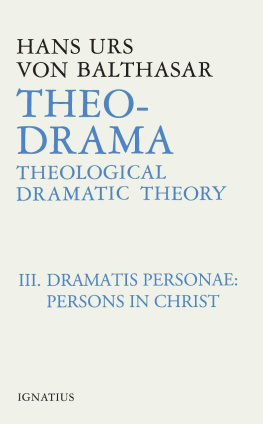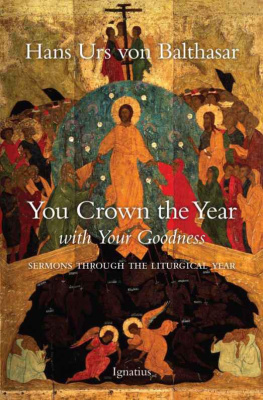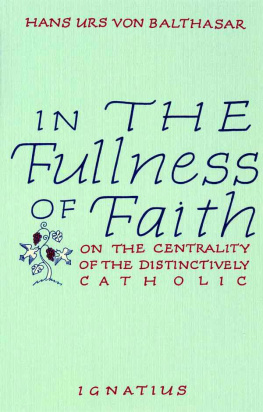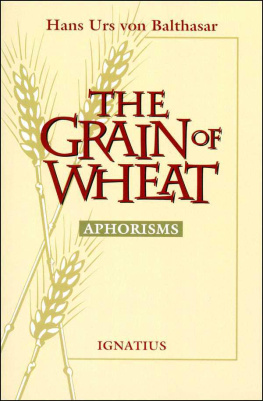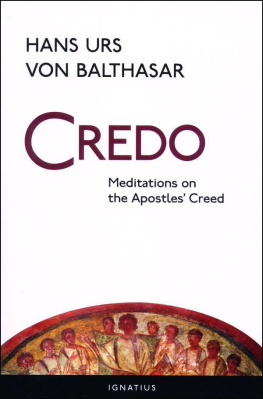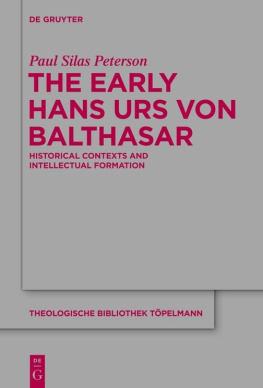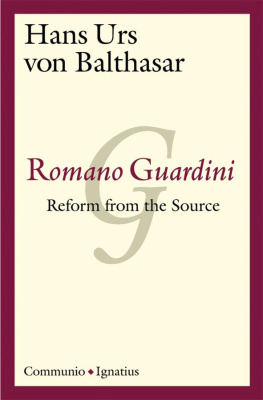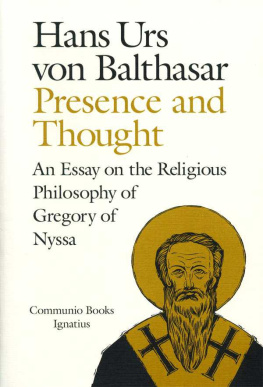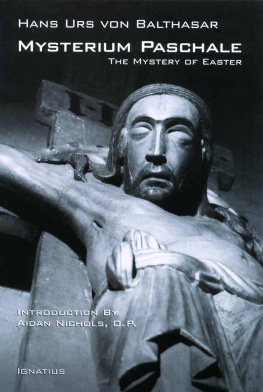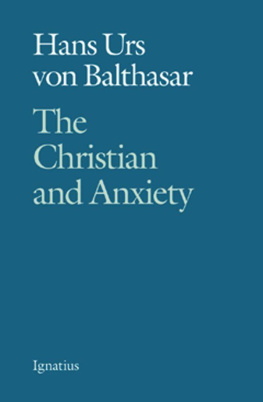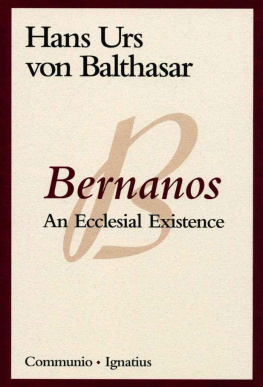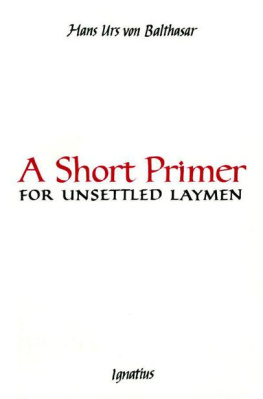TRAGEDY UNDER GRACE
HANS URS VON BALTHASAR
TRAGEDY UNDER GRACE
Reinhold Schneider on the Experience of the West
TRANSLATED BY BRIAN MCNEIL, C.R.V.
A COMMUNIO BOOK
IGNATIUS PRESS SAN FRANCISCO
Title of the German original:
Nochmah: Reinhold Schneider
1991 Johannes Verlag, Einsiedeln, Freiburg
The author prepared this
revised and expanded edition of
Reinhold Schneider: Sein Weg und sein Werk
before his death in 1988
Cover by Roxanne Mei Lum
1997 Ignatius Press, San Francisco
All rights reserved
ISBN 978-0-89870-555-3
Library of Congress catalogue number 96-78008
Printed in the United States of America
Written for and dedicated to
the Secular Institutes
CONTENTS
PREFACE TO
THE NEW EDITION
The first edition of this book was placed in the hands of Reinhold Schneider when he turned fifty in 1953, with the request not to read it if my presentation confused him and dammed up the flow of his inspiration. The preface emphasized how much his mighty work is the fruit of prayer and renunciation and the giving of testimony, in such a way that the person, harassed through and through and exhausted by intellectual and physical pain, unshaken either by boycott and slander or by the many honors paid him, wished to recede totally behind his task, and succeeded in doing so. What most fascinated me in this work was the omnipresent drama of the encounter between two missions that are equally original and yet stand in a deadly mutual conflict: the mission of the one who is entrusted with the task of administering the earthly realm and the mission of the saint as the real symbol of the kingdom of God that descends into the world. The inescapable quality of this encounter appeared to me as a guiding image, an image to be retained at all costs, for the secular institutes that had recently been permitted to exist in the Church: their fundamental aim is to combine the radicalism of the gospel with a total, active involvement in secular work, enduring in their own selves the conflict described here. At that time, it was not yet possible to recognize how deeply and variously Reinhold Schneider had thought through this problem, returning to deal with it again and again and averting one-sided solutions; one may well say that only the publication of his diaries from 1930 to 1935 (almost a thousand pages) has shed sufficient light on his ever new struggle with what he saw as the decisive and tragic conflict between life in the world and transcendenceand this in the years before his return to the Catholic faith. And what position does the writer take on this fundamental problem of Christian existence? Faith addresses the indivisible man. This is why it is so senseless to make a distinction between the statesman as politician and the statesman as Christian, between the Christian as soldier and as the one who kneels at the communion rails. So if faith is present, it flows into the literary composition. And yet there is active here Kierkegaards doubt, which I cannot rob of its force: Is it genuinely possible to busy oneself with brush and paint, with pen and ink in the face of Jesus Christ: to paint Jesus Christ in the face of Jesus Christ? Where in the Gospel, in the whole of Sacred Scripture, is there one, single, even roughly adequate sentence that would provide a basis for art? Christ, the truth in flesh and blood, does not give teaching about himself as the truth but summons people to follow him. Ought the writer to lead people into this following of Christ through his forms and images? But the writer has no priestly office; he does not stand in the pulpit or at the altar; it is not his task to preach. He is a child of this world and a man who is lacerated in his innermost being by the contradictions between faith and artistic activity, between the way that is the truth and his career.
My book may perhaps have provided the occasionperhaps the final pushthat prompted Reinhold Schneider to make the same dramatic turn in his lifes history that Kierkegaard made, and the words quoted here show that they came from a deep motivation: the turning from a neutral and anonymous bearing of testimony to what Kierkegaard called gesticulating with ones whole existence. The latter had hidden his existence behind pseudonyms, presumably already as a witness to the faith, and he states explicitly in his Journal that tins was because my personality does not correspond to the personality of the one to whom witness is borne. When Reinhold Schneider emerged, one year after the publication of my book, with his autobiographical Verhllter Tag (1954), this was because he, like the Dane, had no other weapons available to him now. Kierkegaard had written Up to this point I am a writer, certainly nothing more, and it is a desperate struggle to see whether I can have the will to go beyond my boundary (July 30, 1849). In my introduction, I had emphasized that I had omitted the entire biographical element in my presentation in order to display only the form of the work. But from this point onward, Reinhold Schneider would seek to refute the possibility of such a presentation by unceasingly arguing with his own existence, from the Verhllter Tag to Balkon (1957) and the posthumous Winter in Wien (1958). The publication of his letters to various correspondents, and finally of his Tagebcher , only served to continue this work of yielding up his own self If one prescinds from the novel (a genre that Schneider had detested hitherto) Die silberne Ampel of 1956, a work questionable in its delight in fables and its genealogical labyrinth, then we can see the author fighting in his last works with the sword of his own existence, obliged to pay the price (which Kierkegaard had recognized and feared) of the incongruence between the one who bears witness and that to which he bears witness; Schneider paid this price also with his melancholy.
This meant that he handed over his work to the termite work of a, more or less, depth psychology, which was launched well and truly 0n its way with the appearance of his final work, Winter in Wien : Did the writer deny his Christian conversion here and return to his more nihilistic origins, or could the pitiless disclosure in this work perhaps be interpreted as the path into the cloud of a mystical dark night? Exceedingly contradictory voices clash in Widerruf oder Vollendung (1981), Might it be possible to unite the extreme solutions in a central point and speak of a critical night of faith? This analysis of Schneiders soul as a case has come to occupy the central ground with the result that the objective message of the great works has ceased to be heard. Their urgent hammerbeats scarcely reach contemporary ears, unless in the sense that those who are on the lookout for something more modern see through the themes treated by Schneider as hopelessly backward-looking and oriented to traditions that have completely disappeared, or else in the sense that his works are dismissed as questionable products of a mood of pessimism that does not help us with our own tasks. But it is only today that one recognizes the extreme courage, indeed, the audacity with which this authors chief works offered open resistance to tyranny: Philipp II was under suspicion; Innozenz III (1931) could not appear for political reasons; Die Hohenzollern (1933) was suppressed shortly after publication. They were for the moment very unpopular in high places, and similarly the book about England (1936) had to be withdrawn in the same year in which it was published. There followed his exclusion from the Chamber of Writers of the Reich, the prohibition against publishing his books (which compelled Schneider to have them printed in Alsace), and finally the command to go to the Western front dead or alive (he was at the end of his strength), to help in building traps for tanks



